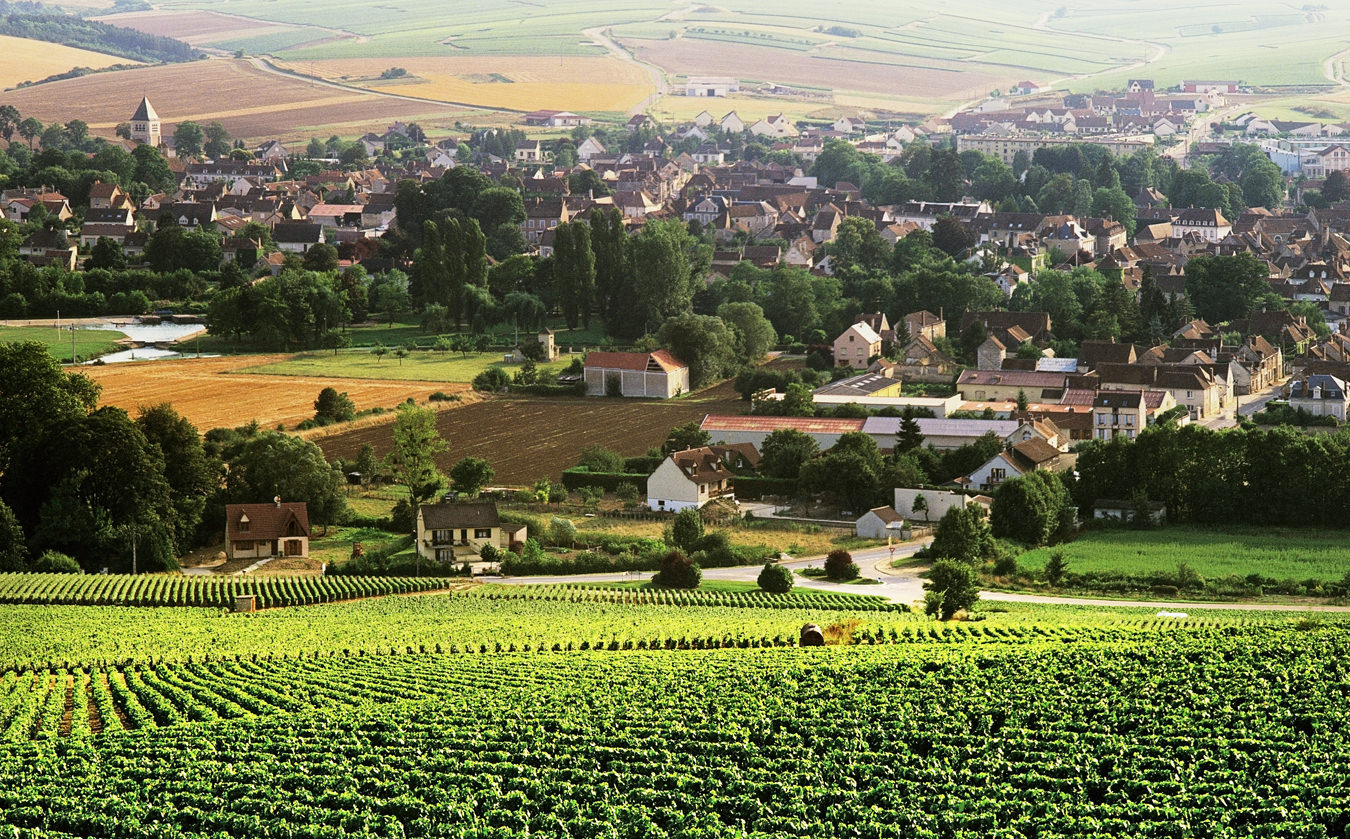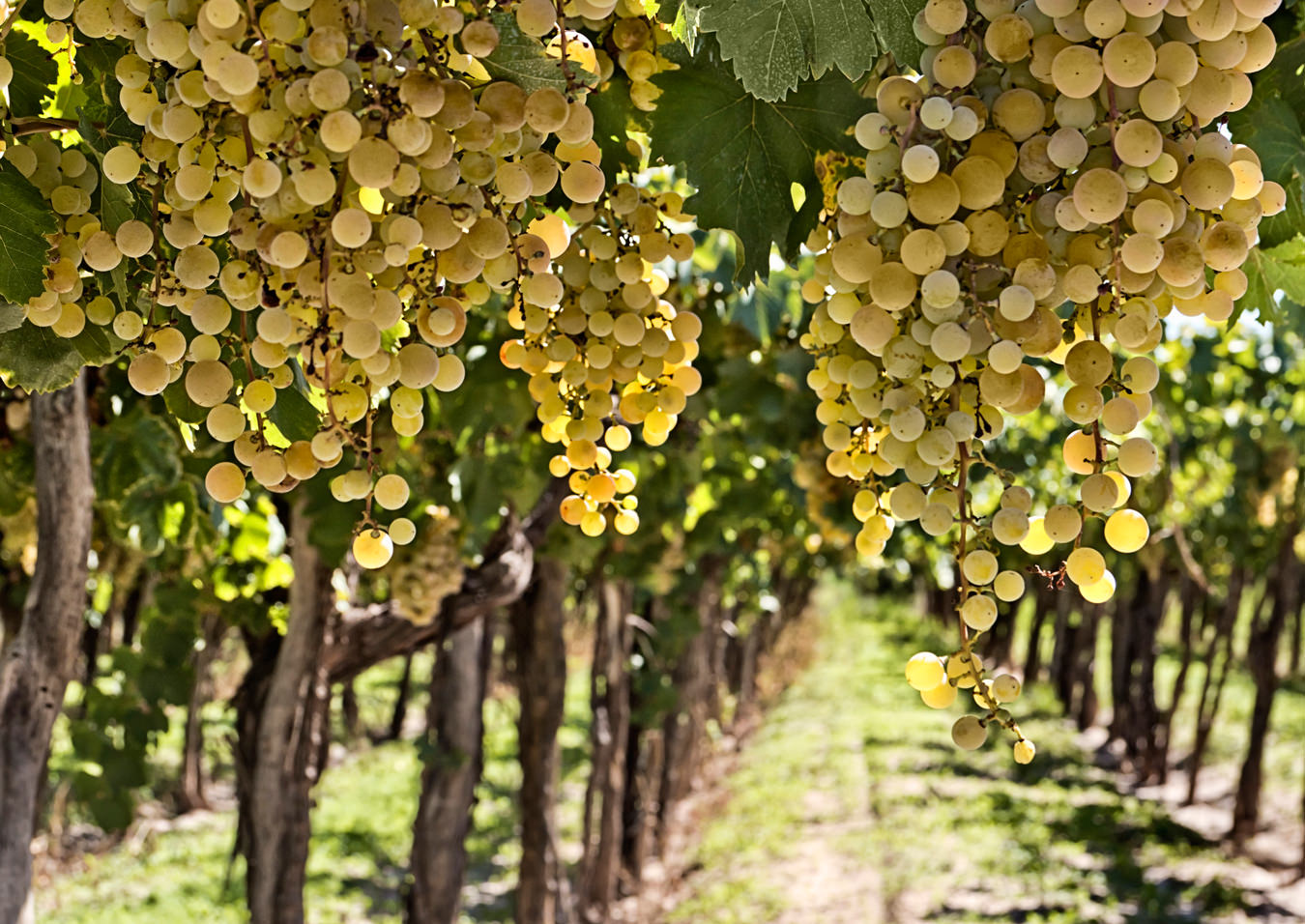-

Chablis is a tiny town in north-central France that produces one of the finest expressions of chardonnay. Photo ©kodachrome25, istockphoto.com.
-

Ready-to-pick chardonnay grapes. Photo ©Patrik Stedrak, istockphoto.com.
All About Chardonnay
The most popular and reviled grape variety of all.
It’s said that not only did sales of pinot noir soar in the United States after the grape variety starred in the 2004 movie Sideways, sales of merlot fell as a result of the declaration made by Miles Raymond (played by Paul Giamatti): “If anyone orders merlot, I’m leaving. I am not drinking any fucking merlot!”
Chardonnay has never been subjected to such a public assault, but many people have made the same point (usually less vigorously) in private conversation. These individual rejections of chardonnay (potentially death by a thousand cuts, rather than one lethal one) add up to what has become known as the ABC—Anything But Chardonnay—movement, which wine writers and people in the wine industry have talked about for the last 25 years.
But here’s the thing: although some, perhaps many, wine consumers have either turned away from chardonnay completely or reduced their purchases, many more have rallied to it. Chardonnay is the most widely planted quality white wine grape variety in the world, and the vineyard area devoted to it has steadily increased, from about 75,000 hectares worldwide in 1990, to 150,000 in 2000, to almost 200,000 in 2010. This is not what you’d expect of a variety under siege. In France and Italy, chardonnay has improved its position compared to other varieties since 2000. In the former, where chardonnay is the second most-planted quality white wine variety, Burgundy and Champagne are especially important. Both countries make wines from chardonnay, and go from strength to strength.
In the New World, the big wine-producing regions have seen chardonnay planted more and more widely. It’s estimated that chardonnay accounts for one in every five bottles of wine sold in the United States. Chardonnay has made headway since 2000 in South Africa, and it is a key variety in Canada’s wine industry, too. In British Columbia, it comes a close second to pinot gris, the first most-planted white grape, and land planted with chardonnay vines increased by 9 per cent between 2011 and 2014. In Ontario, chardonnay is the single most important grape variety. One in five bottles of VQA-designated single-varietal wines (red and white) is chardonnay, and the grape occupies an eighth of all land dedicated to vineyards.
Chardonnay is the most widely planted quality white wine grape variety in the world, and the vineyard area devoted to it has steadily increased.
The major exception to this pattern is Australia, where the area planted in chardonnay has fallen by a third since 2007. But total vineyard area there has declined by more than a fifth, and even shiraz—Australia’s signature grape variety—has lost ground, figuratively and literally.
Clearly, chardonnay grapes are widely grown because there is robust demand for the wine (producers don’t expand plantings of varieties whose popularity is in decline). And while most of this chardonnay is made for the mass market at affordable prices, it’s also the grape variety that makes some of the most prestigious wines, such as Chablis and other white wines from Burgundy. The word chardonnay doesn’t appear on the labels, but it’s the variety responsible for such famous appellations as Corton-Charlemagne and Meursault. Chardonnay is also a component of most champagnes, and it is the only variety in most of the champagnes made in the Blanc de Blancs style, which is limited to white grape varieties.
The ABC effect then seems to be minor, even though it has received a lot of coverage since the 1990s. How to explain the poor reputation of chardonnay in some quarters and the belief that there had been a widespread rejection of the variety? Perhaps it was a generalization of some wine writers’ own attitudes. Some years ago, the highly respected English wine writer Jamie Goode noted of chardonnay, “Although I’m an ardent fan of this grape variety, even I have found myself wanting a break from its rather obvious charms.” Why? “Chardonnay is everywhere, it’s all pervasive. You can’t get away from it. In the wine-drinking world of today, the word ‘Chardonnay’ is synonymous for ‘dry white wine’.”
Maybe chardonnay’s success made it its own worst enemy. It was planted just about everywhere (including Ukraine, Luxembourg, and Brazil), it flooded store shelves, and a certain sameness began to dominate mass market brands as producers tried to emulate the style that was selling best. This happens with hot varieties. It happened with Australian shiraz, New Zealand sauvignon blanc, and Argentine malbec. And although chardonnay might have been the default white wine (often served as anonymous house white), other white varieties began to pop up, in particular sauvignon blanc and riesling. What is worth noting is that chardonnay held its own against these newcomers.
If there was a rebellion of sorts against the monotony of mass-produced chardonnays, there was also a reaction against some specific styles, notably chardonnays that showed a lot of evidence of oak aging. Oak barrels began to be used for the storage and transportation of wine about 2,000 years ago, when they replaced the clay amphorae that had been used to ship Greek and Roman wine for thousands of years. Originally then, barrels were not intended to add flavour or anything else to the wine. They were used over and over, and although some flavours and tannins would have influenced the wine contained in the barrels when they were new, after a few years’ use the wood would become inert and able to add nothing to the wine. Even then, however, barrels had an influence on wine because they allowed the wine some contact with air.
While most of this chardonnay is made for the mass market at affordable prices, it’s also the grape variety that makes some of the most prestigious wines, such as Chablis and other white wines from Burgundy.
At some point (it’s not clear when, but probably as recently as the 19th century), people developed a preference for wine that showed some oak flavours. Pine tree resin has a similar history. It was first used to seal the inside of amphorae, but consumers liked its flavour, so producers added—and continue to add—resin during fermentation long after amphorae had stopped being used, to make the retsina wines popular in the eastern Mediterranean.
Certain grape varieties have a particular affinity to oak. The classic red wines of Bordeaux (especially merlot and cabernets sauvignon and franc) and Burgundy (pinot noir) are generally aged in oak barrels. But although some sauvignon blancs are aged in oak barrels to produce the fumé style, chardonnay is the white grape variety that most often gets oak treatment. The problem is that chardonnay is a fairly neutral variety (it has moderately intense flavours and acidity, which make it amenable to being steered in many directions in the winery), which can lead to its being overwhelmed by oak flavours.
Starting in the 1990s, there were complaints that some chardonnays were being overoaked and that the fruit flavours were being dominated by flavours of wood, in the same way that some Scotch whiskies are dominated by peat. Just as some consumers love peaty whisky, some prefer well-oaked wines, but it became common to hear complaints that some chardonnays, mainly identified with California, were unbalanced because the oak obliterated the fruit flavours. It was never clear whether these chardonnays were very common, but there developed a cultural reaction against oak, despite the fact that many of the most sought-after wines are aged in oak barrels, whether they are from Burgundy, Bordeaux, Rioja, Bolgheri, or Chianti.
This sense that wines—and especially chardonnay because it is quintessentially neutral—were being exposed to too much oak extended to winemakers, and in the last few years many have reduced the influence of oak in their wines. A large number of chardonnays are now labelled “unoaked”, and where oak is used, there is a trend toward reducing its influence. This is part of a more general reorientation of wine style that includes getting away from very ripe fruit and high alcohol. Chris Hatcher, chief winemaker at Wolf Blass in Australia, says that “Since the late 1990s we’ve been moving away from blockbuster wines and going for fruit purity.”
It’s hard to know what to make of the ABC movement, whose prominence seems to have been far greater than its actual effects. The popularity of chardonnay, measured in terms of land area, remained robust even as consumers were portrayed as rejecting it. Preferences for grape varieties do change, but there seems no reason to think that chardonnay will fall on hard times anytime soon. As for ABC, it has been suggested that it should actually stand for Another Bottle of Chardonnay.
Find a list of six recommended chardonnay picks, here.
_________
Never miss a story. Sign up for NUVO’s weekly newsletter.




